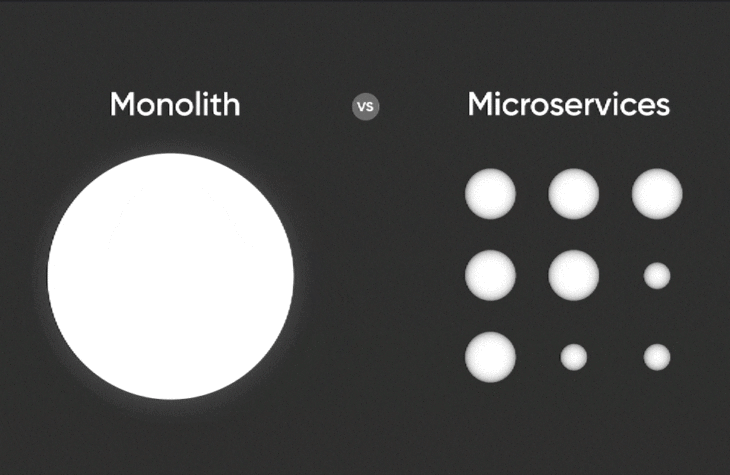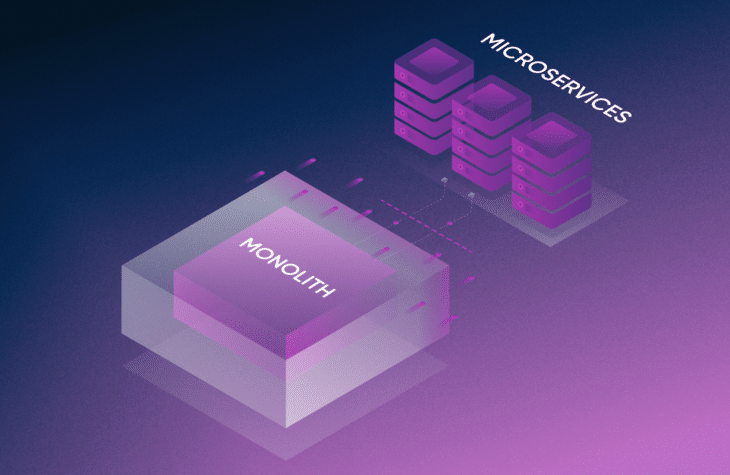7 Powerful Enterprise E-Commerce Platforms for Retail Businesses
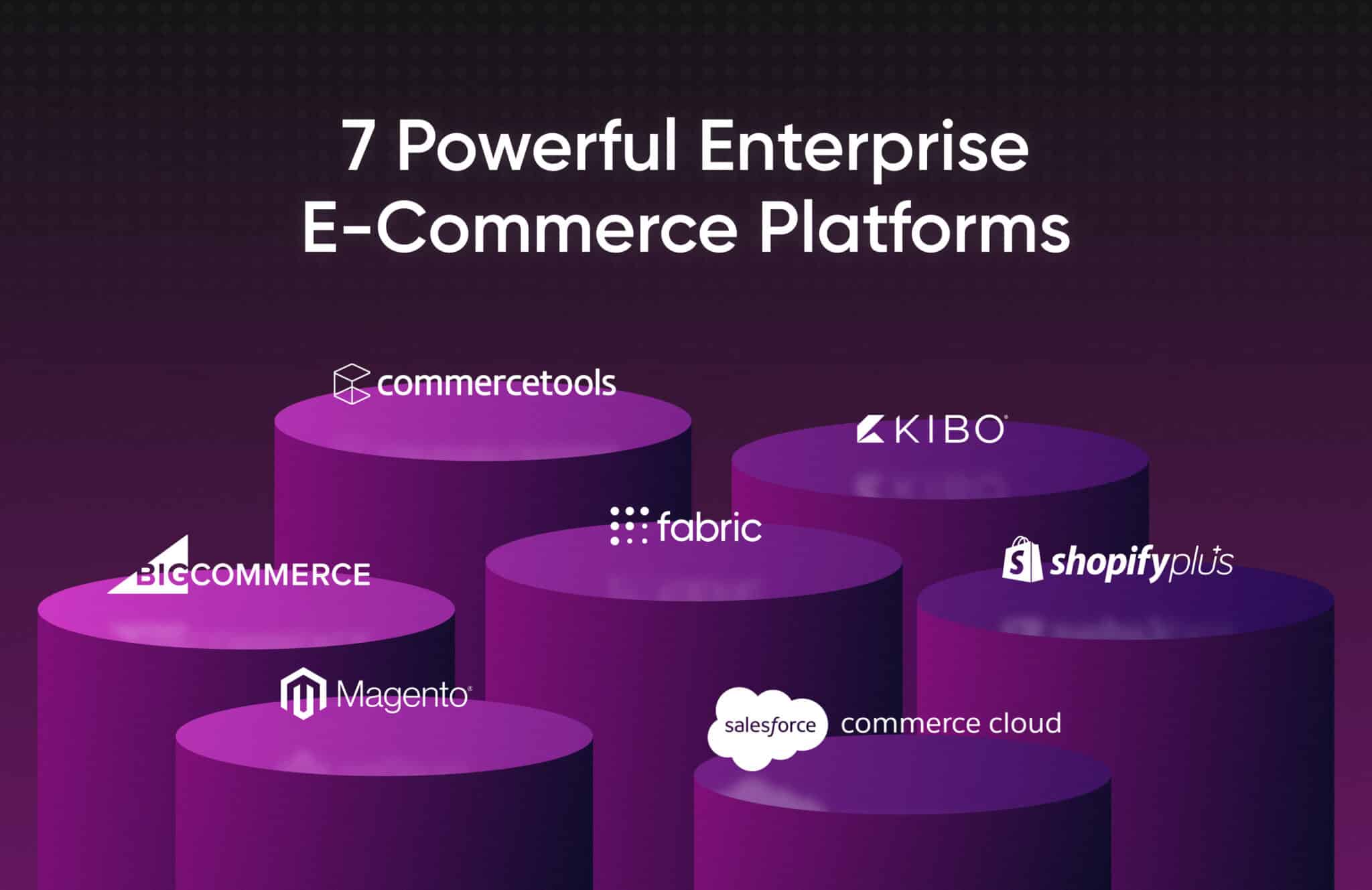
Enterprise e-commerce platforms are built for large retailers with complex supply chains and omnichannel fulfillment operations, providing comprehensive solutions with advanced features and integrations.
Key benefits of using an enterprise e-commerce platform includes greater scalability and performance, agility, configurability, security and compliance, integration capabilities, and modularity.
Replatforming to an enterprise e-commerce platform involves risks, but a modular commerce platform can help de-risk the move from a monolith to microservices.
7 must-know enterprise e-commerce platforms for retailers include fabric Commerce Platform, BigCommerce, Shopify Plus, Salesforce Commerce Cloud, Adobe (Magento), commercetools, and Kibo Commerce.
Enterprise e-commerce platforms are purpose-built to handle the complex needs of large-scale retail operations. The best platforms not only offer all the core commerce functions that are critical for retailers, but they also provide seamless integrations with third-party systems and have scalable cloud-based architecture to ensure optimal performance.
With global e-commerce sales projected to reach $6.3 trillion this year and soar to $8.1 trillion by 2026, it’s now more important than ever to invest in a platform that can adapt and scale as your business grows.

As global e-commerce sales rise, it’s now more important than ever to invest in a platform that can adapt and scale as your business grows.
A powerful solution for enterprise
Enterprise e-commerce platforms are purpose-built to handle the complex needs of large-scale retailers. The best platforms not only offer all the core commerce functions that are critical for retail, but they also provide seamless integrations with third-party systems and have scalable cloud-based architecture to ensure optimal performance. For omnichannel retailers, these cutting-edge solutions can help to deliver seamless shopping across various channels and improve the overall customer experience.
In this article, we’ll take a deep dive into what you need to know about these platforms. We’ll go over factors to consider when making technology buying decisions (including the main types of enterprise e-commerce solutions, the benefits of using these platforms, and the cost of replatforming), but also emphasize the urgency for business and technology leaders to take action sooner.
We’ll also explore seven enterprise e-commerce platforms that empower today’s modern retail businesses. Each platform offers unique features and benefits tailored for enterprise-level businesses, with some of the major players being:
- fabric Commerce Platform
- BigCommerce
- Shopify Plus
- Salesforce Commerce Cloud
- Adobe (Magento)
- commercetools
- Kibo Commerce
What is an Enterprise E-Commerce Platform?
An enterprise e-commerce platform is software that’s designed specifically for the complex needs of large-scale retail businesses. It enables online commerce for merchants and consumers by providing the necessary infrastructure, features, and integrations to support internal and external e-commerce functions.
The core commerce capabilities of a platform generally cover product, pricing, promotions, search, inventory, orders, cart, checkout, and user identity. Also known as e-commerce primitives, these core functions power everything in commerce, including inventory management, order management and processing, customer relationship management (CRM), marketing, payments, analytics, and more.
The top enterprise e-commerce platforms are highly flexible, scalable, and composable. Retailers can effectively automate and streamline complex operations, integrate with best-of-breed third-party systems, eliminate manual processes, adapt to changing market demands, and allow businesses to allocate resources to more strategic initiatives, such as delivering superior products and services to customers.
Benefits of Using an Enterprise E-Commerce Platform
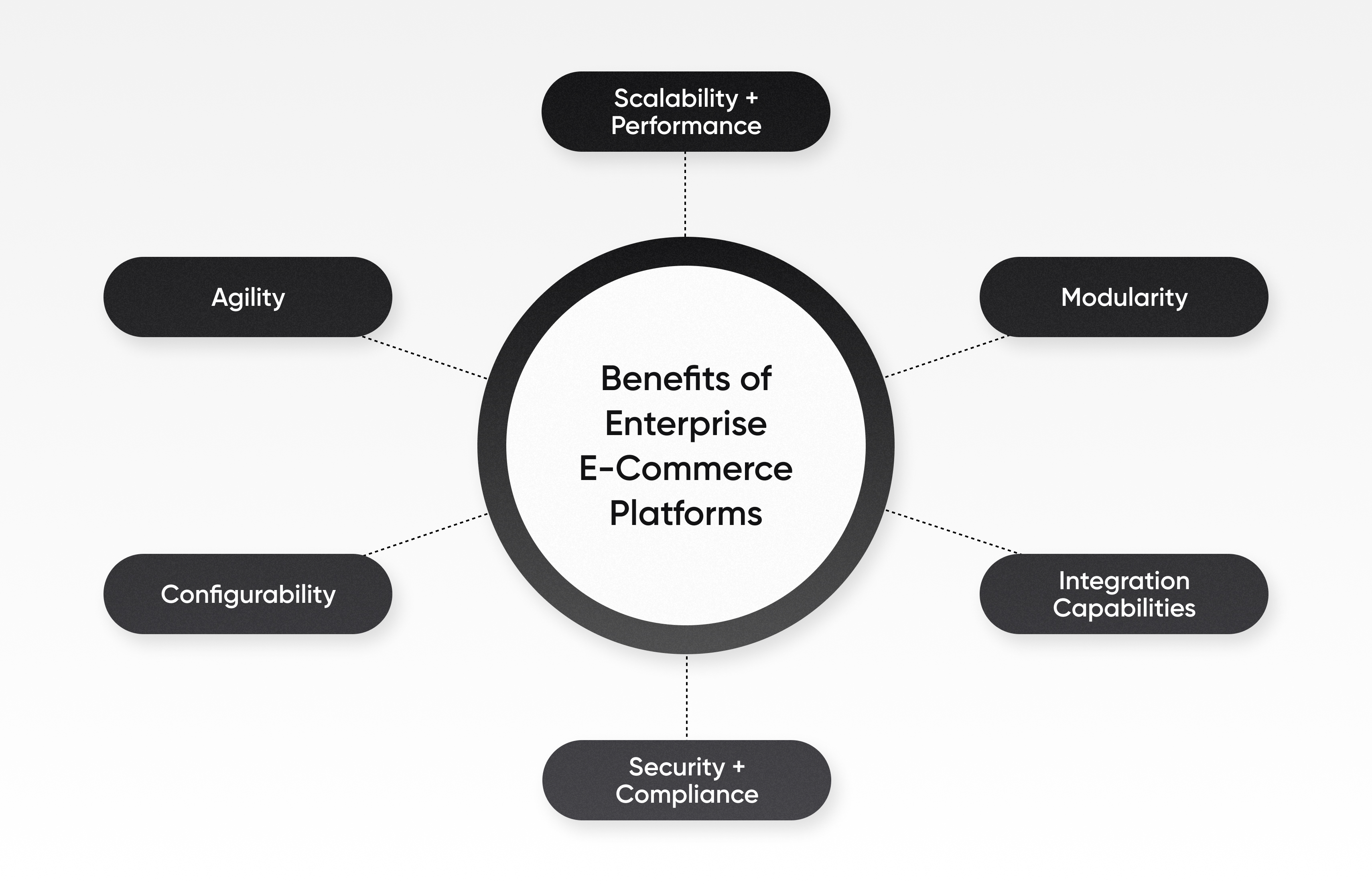
Enterprise e-commerce platforms offer scalability + performance, modularity, integration capabilities, security + compliance, configurability, and agility.
Businesses need to adapt to keep up with the evolving demands of the market and to deliver superior shopping experiences to their customers. When a platform becomes inadequate and hinders growth, it’s generally time to transition to a more powerful solution. Some of the benefits of transitioning to an enterprise commerce platform include:
Scalability and Performance
Scalability measures a system’s ability to increase or decrease in capacity and cost in response to changes in application and system processing demands. In e-commerce, it is the ability of a platform to accommodate increased workloads and growing demands while staying stable (and performant).
Examples of platforms that were incapable of scaling to meet surging demand include Nike’s and Ulta Beauty’s websites during Black Friday sales in 2022. A scalable e-commerce platform ensures that a website remains responsive and stable even during peak traffic surges. Enterprise-grade platforms are not just built to handle high volumes of traffic, they’re also capable of handling more users, a growing product catalog, and higher order volumes as a business expands. High-growth companies should pay special attention to the benefit of scalability when evaluating software.
Performance is critical as well. Performance is about how fast a system responds or can process transactions or return results. A powerful platform can ensure that page load and inventory retrieval speeds are lightning quick, while scalable infrastructure, high-performance caching and optimization, mobile responsiveness, and reliable uptime can lead to better conversions and higher sales.
Agility
Agility in the context of an enterprise e-commerce platform refers to the platform’s ability to adapt and respond swiftly to changes in the business environment. This includes the capability to quickly introduce new products, update pricing, modify promotions, and adjust to shifting market trends. Agility de-risks platform investments by allowing implementation of the platform one module at a time, and therefore, improves the time to value.
Legacy monolithic e-commerce platforms are less agile as even small software changes require wholesale updates and testing of an entire tech stack. Additionally, all components are tightly coupled into a cohesive system, making it harder to understand, modify, or extend the system. In contrast, headless and modular platforms are more agile and can enable businesses to make timely adjustments to meet market demands without major disruptions.
Configurability
Every business has its own specific needs and branding requirements. Therefore, it’s no surprise that one key benefit of enterprise e-commerce platforms is the flexibility for it to be customized according to the specific needs of a business.
Customization options allow businesses to build more unique and personalized shopping experiences for customers. Modern e-commerce platforms empower non-technical users to personalize customer experiences and set business rules using powerful, UI-based tools, thereby, improving speed to launch new features and reducing development time. Plus, this flexibility allows companies to adapt to market trends quickly and scale their operations as they grow. A configurable platform allows companies to tailor the user experience, checkout process, order management, and other features to align with their brand identity and customer expectations.
Security and compliance
Enterprise organizations face distinctive challenges when it comes to PCI compliance and managing data security. One such challenge arises from the substantial amounts of card data they store and transmit. Enterprise e-commerce platforms can help businesses comply with the Payment Card Industry Data Security Standard (PCI DSS).
Organizations that store, process, or transmit any kind of customer data should also have a SOC 2 Type II Report, which is a Service Organization Control (SOC) audit on how a cloud-based service provider handles and safeguards sensitive customer information. Completed by an independent auditor, it covers internal controls for security, confidentiality, processing integrity, privacy, and availability of customer data.

Organizations that store, process, or transmit any kind of customer data should also have a SOC 2 Type II Report, which is a Service Organization Control (SOC) audit on how a cloud-based service provider handles and safeguards sensitive customer information.
Integration capabilities
For any online business, it’s critical to be able to integrate with various third-party systems, such as enterprise resource planning (ERP) systems, customer relationship management (CRM) systems, payment gateways, and more. Integrations not only enable retailers to personalize and improve the shopping experience, they also help to automate processes and streamline operations.
Modularity
Modularity refers to the ability of an enterprise e-commerce platform to be composed of separate, interchangeable e-commerce components or modules. Generally, applications are broken down into smaller, modular, and independent services that communicate via APIs. Modularity allows businesses to add, remove, or replace specific features without disrupting the entire system. It provides for greater flexibility and agility and can simplify maintenance, upgrades, and the introduction of new functionalities.
Going a step further, composable commerce is where modular components are combined and integrated to create a customized e-commerce ecosystem. By composing a platform using best-of-breed modules, companies can build fully-customized digital commerce solutions that are tailored to their specific needs.
7 Powerful Enterprise E-Commerce Platforms for Retailers
fabric Commerce Platform
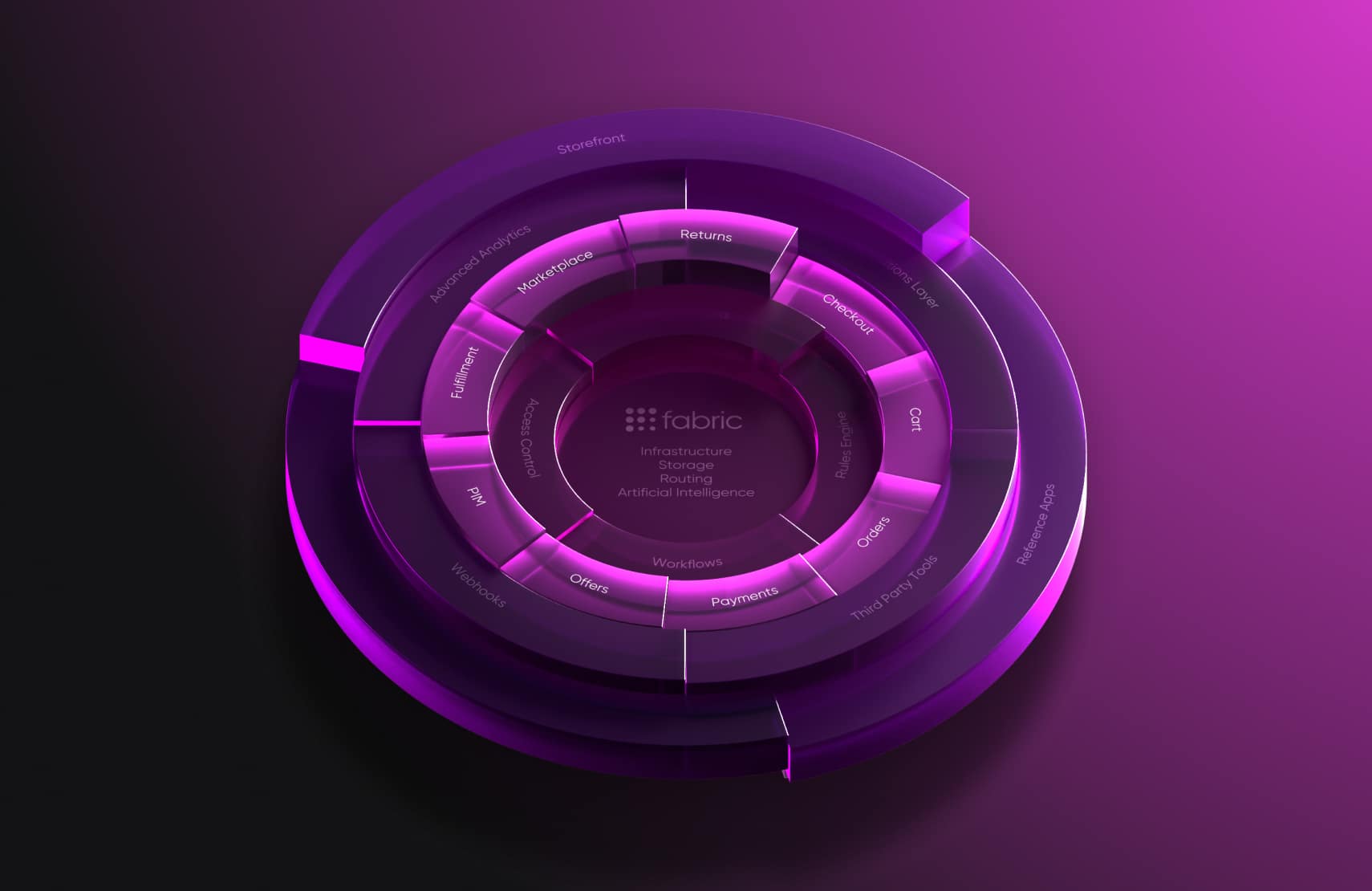
The fabric Commerce Platform provides the fastest, most flexible e‑commerce platform that allows merchants to innovate at lower risk.
fabric Commerce Platform is a platform of APIs and user interfaces for B2C and D2C retailers to support merchandising, catalog expansion, pricing and promotions, inventory availability, order lifecycle management, omnichannel fulfillment, and online shopper transactions. It offers a comprehensive suite of enterprise e-commerce solutions, while its modular architecture and extensive customization options make it an ideal choice for omnichannel retailers seeking flexibility and scalability.
fabric Commerce Platform is purpose-built for retailers who need agility, performance, and speed of execution. Its modular and extensible solutions are fast and eliminate vendor lock-in and allow retailers to implement one module at a time, therefore shortening the time to value. Its API response times are near instant and can attract and convert more shoppers, while its core commerce services are highly configurable and allow business users to achieve more with less.
Whether enterprise e-commerce brands want to extend their business models (a dropship marketplace), require powerful capabilities to handle complex operations and omnichannel fulfillment models (BOPIS or curbside pickup), or want robust multisite functionality support for multiple websites, fabric Commerce Platform is a powerful, composable solution for building personalized and superior shopping experiences for customers. fabric is named a Strong Performer in the 2023 Gartner® Peer Insights™ ‘Voice of the Customer’ for Digital Commerce.
commercetools

commercetools is a cloud-native, headless commerce platform that offers flexibility, scalability, and easy integration with existing systems.
Headquartered in Munich, Germany, and with offices around the globe, commercetools is a cloud-native, headless commerce platform that offers flexibility, scalability, and easy integration with existing systems. Not only are they the inventors of headless commerce, but they’re also the ones behind MACH architecture, which was born from commercetools’ founder Dirk Hoerig. MACH stands for Microservices-based, API-first, Cloud-native, and Headless.
Some of commercetools’ main features include headless commerce APIs, catalog management, unified cart, order management, machine learning, developer tools, and a merchant center to manage product information, order data, and more.
However, while commercetools offers a high degree of composability, it lacks multiple features out-of-the-box and customers have fewer choices for third-party services. Additionally, commercetools is often accompanied by a high degree of complexity in the implementation. The need to build and maintain custom middleware can place an ongoing resource burden on the merchant and increase the time required to launch. Commercetools lacks dropshipping and marketplace operations capabilities as well.
Salesforce Commerce Cloud
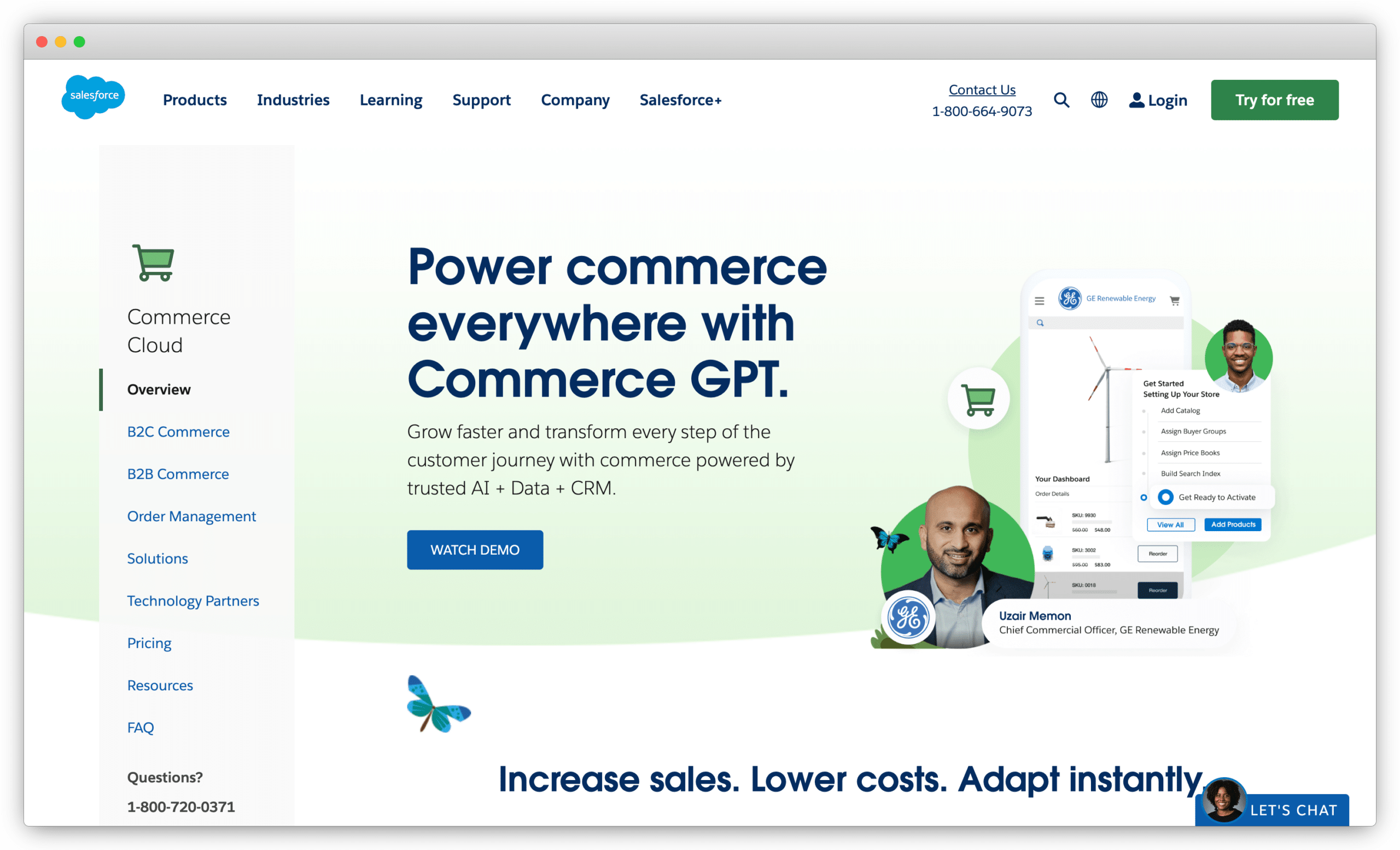
Salesforce Commerce Cloud is a legacy e-commerce platform with a large ecosystem. Its B2B Commerce offering is built on the Salesforce Lightning platform which contains individual modules that can be composed together to provide commerce functionality across its whole digital commerce product range.
Salesforce Commerce Cloud is a multi-tenant, cloud-based commerce platform that powers commerce everywhere with AI, data, and CRM, offering customers innovative and flexible storefronts for their business. Built on the Salesforce Platform, Commerce Cloud delivers embedded commerce experiences with easy use cases that drive revenue. It provides a comprehensive set of features, including AI-powered personalization, omnichannel capabilities, and extensive developer tools. The company’s most popular configuration includes a comprehensive solution for end-to-end, unified commerce, but it’s also available as two stand-alone product lines—Salesforce B2C Commerce and Salesforce B2B Commerce.
Salesforce Commerce Cloud is a legacy e-commerce platform with a large ecosystem. Its B2B Commerce offering is built on the Salesforce Lightning platform which contains individual modules that can be composed together to provide commerce functionality across its whole digital commerce product range.
Salesforce B2C Commerce is the result of the acquisition of Demandware in 2016. This means that the offering can still integrate with apps in the Salesforce ecosystem and can also integrate with many third-party services, but it does not benefit from the modularity and composability of being built on the Salesforce Lightning platform.
Additionally, the B2C Commerce offering locks customers into long-term contracts with revenue share models that increase as businesses scale. Customers are essentially penalized for high growth, as the more they sell, the more they have to pay. Salesforce also requires clients to purchase additional add-ons for basic commerce functions. For example, adding fulfillment locations is an add-on to their OMS offering.
Adobe Commerce (Magento)
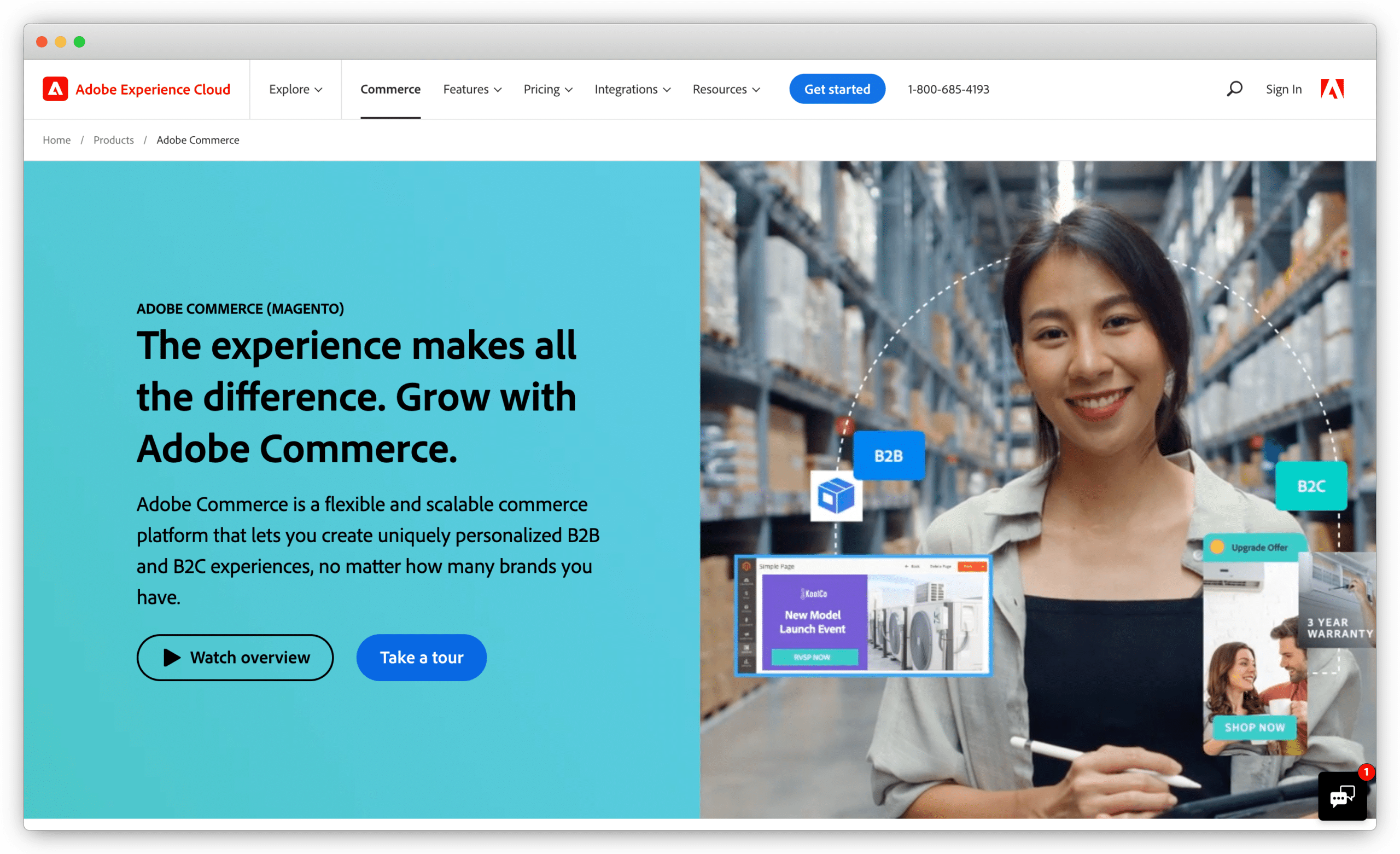
Adobe Commerce, formerly known as Magento, is a robust and flexible platform that caters to the needs of enterprise-level merchants and brands. It’s built on a scalable, open-source platform, but some of the platform’s most important features require a paid plan.
Adobe Commerce, formerly known as Magento, is a robust and flexible platform that caters to the needs of enterprise-level merchants and brands. It’s built on a scalable, open-source platform and offers extensive customization options, and a vibrant ecosystem of extensions and integrations. Some of the platform’s most important features include extensibility, live search, product recommendations, and payment services. Adobe Commerce Pro is their all-in-one package for merchants while Managed Services provides hosted and managed application and infrastructure on cloud infrastructure Pro plans.
However, expert-level managed services come with a price. Ongoing solution management can quickly add up for things like maintenance, upgrades, new releases, and more. Additionally, upgrading Adobe Commerce applications can be a challenge. Users have found the platform to be costly, time-consuming to use, and hard to customize. Commerce is also not a core focus for Adobe. Its platform is commonly viewed as a legacy platform that’s less flexible and agile and lacks support for omnichannel fulfillment models.
Kibo Commerce
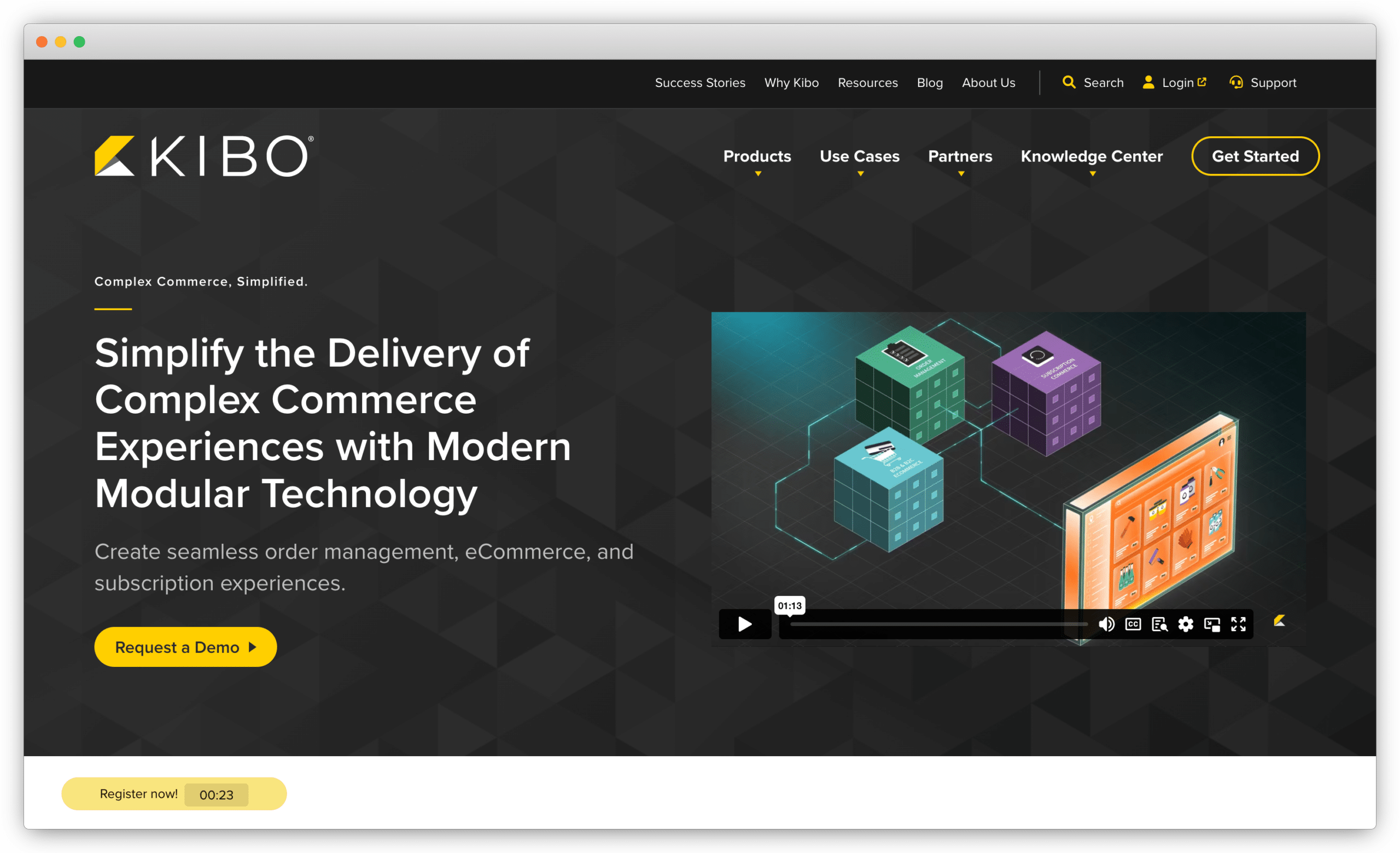
Kibo integrates various commerce functionalities, including order management, e-commerce, and subscription technologies. The platform helps to bring simplicity and sophistication to commerce operations.
Kibo Commerce is a composable e-commerce platform that provides a suite of solutions to help businesses simplify the complexity in their businesses and deliver modern experiences for their customers. It offers a platform that integrates various commerce functionalities, including order management, e-commerce, and subscription technologies. The platform helps to bring simplicity and sophistication to commerce operations and exceed customer expectations.
Across Kibo Commerce’s modules, businesses can expect a wide range of features, including improved inventory visibility and order routing, catalog, pricing and promotions, cart and checkout, and search. While the platform’s order management capabilities have generally had positive reviews, some users have noted that high costs and its inflexibility in managing custom integrations are some of the platform’s drawbacks . The platform also lacks support for dropshipping and marketplace operations.
BigCommerce
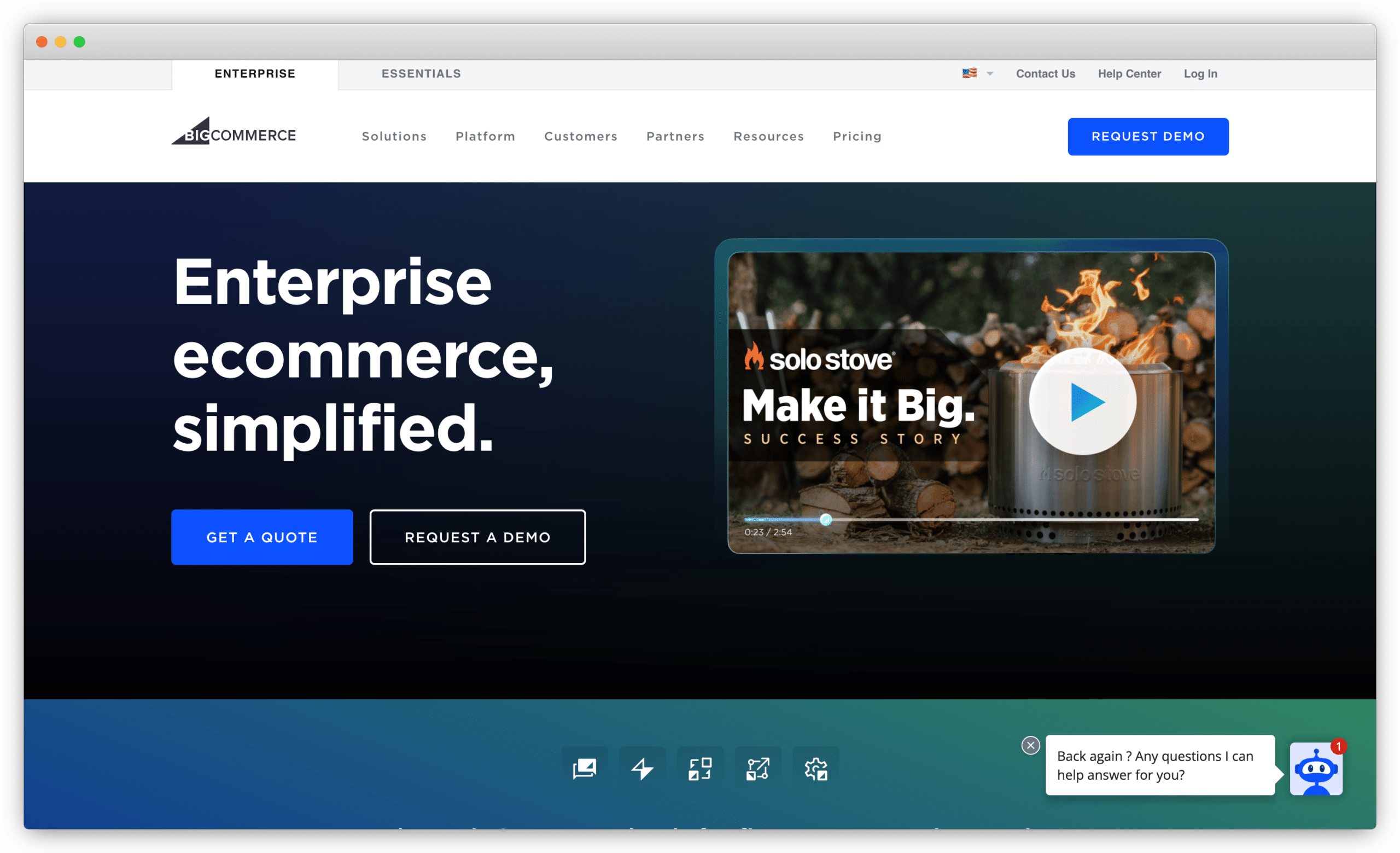
BigCommerce provides a robust and scalable platform with a wide range of built-in features and integrations that are available out-of-the-box. It offers enterprise-level functionality and excellent support, empowering retailers to create engaging and personalized shopping experiences. As one of the more mature offerings on the market, the company has proven its value with small and midsize B2B and B2C retailers.
BigCommerce’s open SaaS solution offers API enabled openness and flexibility, giving enterprise retailers the integrations and tools they need to customize their platforms. According to reviews from BigCommerce users, some of the pros include the platform ecosystem and integrations, as well as customer service. However, BigCommerce lacks some core commerce capabilities and the platform may not be the best choice for enterprise businesses as its customer base remains heavily skewed toward the small and midsize business (SMB) segment.
Shopify Plus
Shopify Plus is an enterprise e-commerce platform known for its ease of use, out-of-the-box features, and extensive app marketplace. It provides scalability, security, and advanced customization options, making it a trusted choice for many global brands.
With Shopify Plus, enterprises gain access to Shopify apps and partners. They also have Shop Pay, which is the best-converting checkout on the internet. Based on customer reviews, some of the platform’s highest-rated features include data orchestration, decoupling, and performance and reliability, while the lowest-rated features include B2B capabilities, promotions and discounts, and recommendations/personalization. Shopify Plus is also not the strongest platform for enterprise e-commerce brands with complex business models and does not offer strong multisite support for businesses.
Commerce Components by Shopify (CCS) is the company’s newest offering which gives enterprise retailers access to Shopify’s foundational components and flexible APIs to build customer experiences that integrate with a retailer’s preferred back office services. CCS offers 30 modular components for customers to use or integrate with existing third-party services. That being said, CCS was launched in 2023 and therefore there isn’t enough market evidence to comment on the quality of the offering yet.
How to Find the Best Enterprise E-Commerce Platform for Your Business
Finding the best enterprise e-commerce platform requires careful evaluation of your business requirements, goals, and budget. Businesses should always plan ahead for the future, which means they need to evaluate a platform’s scalability, customization options, integration capabilities, support and maintenance, security features, and pricing. A few steps to follow include:
Assess business needs
Every business is different. By evaluating your business requirements, you can identify the specific features and capabilities your enterprise requires in an e-commerce platform.
Research top platforms
Businesses should conduct in-depth research on leading enterprise e-commerce platforms in the market. Some key considerations when evaluating platforms include:
- Agility: Assess the platform’s ability to adapt swiftly to changing business requirements and market trends.
- Scalability: Determine if the platform can seamlessly accommodate business growth and increased transaction volumes.
- Configurability: Explore how easily the platform can be tailored to match specific business processes and workflows.
- Security: Ensure that the platform provides robust security features to safeguard sensitive customer and business data.
- Integrations: Examine the platform’s capacity to integrate smoothly with essential third-party systems and tools.
- Modularity: Consider whether the platform’s architecture supports a modular approach, enabling flexible customization and expansion.
Calculate the e-commerce total cost of ownership (TCO)
By not properly evaluating the total cost of ownership, businesses can end up paying a hidden e-commerce tax. However, choosing the right e-commerce platform can create a fast payback period that can boost margins and improve profitability.
Monolithic vs. Headless vs. Microservices Architecture

Monolith
A monolithic e-commerce platform refers to a traditional and all-in-one software architecture where all the components and functionalities of an online store are tightly integrated into a single application. In this setup, different features like product catalogs, inventory management, order processing, payment processing, and customer management are bundled together within the same codebase.
Monolithic e-commerce platforms are characterized by their unified nature, making them easier to develop and deploy but potentially limiting flexibility and scalability as the entire system needs to be modified or updated for any changes.
Headless
A headless e-commerce platform decouples the front-end presentation layer from the back-end functionality. In this architecture, the front-end is separated from the core commerce applications.
This enables businesses to use different front-end technologies and frameworks for creating and managing content, providing more flexibility and better user experiences across various devices and channels. Headless architecture also enables easier scalability and updates, as changes to the front-end do not require modifications to the underlying back-end, streamlining the development and deployment process.
Microservices
Gartner believes that composable business models means modularity, but it first helps to define what the term “modular commerce” actually means.
Modular commerce divides e-commerce functions into discrete modules for enhanced flexibility and customization. Microservices-based architecture breaks down applications into smaller, modular, and independent services. Each microservice performs a specific function and communicates with others through well-defined APIs.
Composable commerce, a term introduced by Gartner, is about assembling and integrating best-of-breed components and services to create a highly flexible and personalized e-commerce ecosystem. A modern composable tech stack involves using various microservices and third-party APIs to build a custom application tailored to the specific needs of the business. This approach allows for greater flexibility, scalability, and easier integration of new functionalities.
Which is best for your business?
Each of these platform architectures comes with its own set of benefits and considerations. Businesses should carefully assess their requirements, budget, and technical expertise to choose the most suitable architecture for their specific needs and growth strategies.
That being said, a headless and modular commerce platform that comes pre-built with a comprehensive suite of core commerce functions differs from pure microservices, but is an ideal middleground because it can leverage some of the unification of the monolithic paradigm. It can offer the scalability, flexibility, extensibility, and composability that enterprise businesses require for more complex retail operations.
What are the Costs of Replatforming?
E-commerce replatforming involves migrating from a legacy platform to a modern e-commerce solution, with factors like business size, complexity, data migration needs, customization, and platform licensing influencing the costs. A well-thought-out strategy and the right technology partner can help lower expenses and mitigate potential challenges, especially when migrating from a monolithic to a microservices platform using the strangler pattern.
A modern headless and composable platform can help businesses lower their total cost of ownership (TCO) by introducing cost savings across the e-commerce tech stack. However, it’s still essential to conduct a thorough cost analysis, including upfront expenses and ongoing maintenance and support costs, while considering the long-term benefits and ROI of the new platform.
Conclusion
Selecting the right enterprise e-commerce platform is crucial for the success and growth of retail businesses operating at an enterprise level. Each of the seven powerful platforms mentioned in this article offers unique features, capabilities, and scalability to meet the specific needs of large retailers.
Whether it’s fabric Commerce Platform, BigCommerce, Shopify Plus, Salesforce Commerce Cloud, Adobe (Magento), commercetools, or Kibo Commerce, it is essential for businesses to assess their unique requirements and evaluate the top options to determine the best fit for their e-commerce needs.
Enterprise E-Commerce Platform FAQ
How do I choose the right enterprise e-commerce platform for my business?
The best enterprise e-commerce platform depends on your business’ unique needs, scale of operations, target market, and pace of growth. Some of the market-leading options today include fabric Commerce Platform, BigCommerce, Shopify Plus, Salesforce Commerce Cloud, Adobe (Magento), commercetools, and Kibo Commerce.
What qualifies a business as “enterprise” in e-commerce?
“Enterprise” status is determined by factors such as business size, annual revenue, number of employees, and complexity of operations. Gartner defines midsize enterprise (MSE) as those organizations that have between $50 million and $1 billion in annual revenues and/or 100 to 1000 employees. Anything larger would be classified as a corporate and major enterprise (CME), which is an organization with more than 500 employees.
There are also retail classifications for companies with $1 billion to $5 billion GMV. For example, large omnichannel enterprises are retailers with their own manufacturing, own stores, and they do not sell heavily through 3rd parties. In contrast, large big box enterprises are retailers that primarily buy products from manufacturers to sell via their physical and digital stores.
How long does the replatforming process usually take?
The duration of a replatforming initiative varies based on project complexity, e-commerce platform size, data migration requirements, and customization needs. The process can take several months, and careful planning is essential to minimize disruptions and ensure a smooth transition.
However, using a migration strategy like the strangler pattern allows a company to migrate services one at a time and as needed, instead using a full-scale big bang approach.
What distinguishes enterprise e-commerce from regular e-commerce?
Enterprise e-commerce caters to larger organizations with extensive resources, complex operations, and high transaction volumes, necessitating robust and scalable solutions. In contrast, regular e-commerce suits smaller businesses with simpler requirements and lower transaction volumes.
What are options for e-commerce hosting?
E-commerce hosting involves storing and managing files, data, and content for online stores on a server, ensuring 24/7 accessibility to customers. E-commerce hosting services offer technical support and infrastructure for smooth, secure, and efficient store operations.
- SaaS (Software as a Service) Hosting: SaaS hosting is managed by a third-party, providing easy scalability and reducing the need for in-house IT support.
- Cloud-Hosted: Cloud-hosted environments provide flexibility and cost-effectiveness through virtual servers from cloud service providers like Amazon Web Services (AWS), Microsoft Azure, or Google Cloud Platform (GCP).
- On-Premise: On-premise hosting offers greater control over data and environment but requires hardware investments and maintenance responsibilities.
- Self-Hosted: Self-hosted e-commerce platforms are similar to on-premises but can be hosted on rented or leased servers instead of the organization’s infrastructure. It provides more control compared to SaaS, but the organization is responsible for maintaining the hosting environment and ensuring security measures.
What are some different types of enterprise e-commerce solutions?

Open-source e-commerce platforms are software solutions whose source code is freely available to the public. Organizations can use the software without paying licensing fees.
Open-source platforms can be either self-hosted, where organizations set up and maintain the software on their servers, or cloud-hosted, where third-party providers offer hosting services for the open-source software. This approach fosters collaboration, community-driven innovation, and customization possibilities.
SaaS (or software-as-a-service) is a software delivery model where applications are hosted and maintained by third-party service providers and made available to users over the internet. Users access the software through web browsers without needing to install or manage the underlying infrastructure. SaaS platforms are cloud-hosted and typically follow a subscription-based pricing model. They offer easy scalability, automatic updates, and reduced IT overhead.
Digital content editorial team @ fabric.




